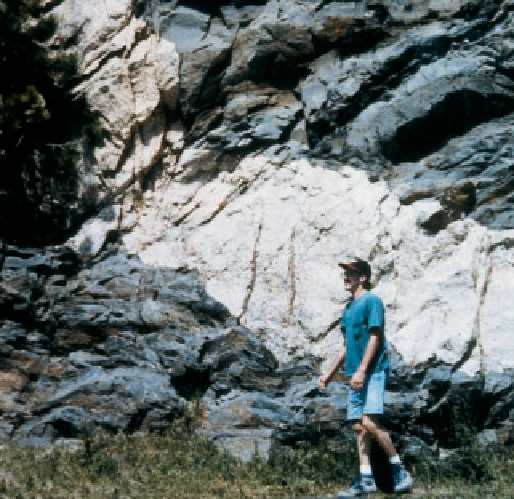Geology Reference
In-Depth Information
◗
Figure 4.15
Pegmatite
b
Close-up view of a specimen from a pegmatite with minerals
measuring 8 to 10 cm across.
a
This pegmatite, the light colored rock, is exposed in the Black
Hills of South Dakota.
rocks where minerals crystallize. This water-rich magma also
contains elements that rarely enter into the common min-
erals that form granite. Pegmatites that are essentially very
coarsely crystalline granite are simple pegmatites, whereas
those with minerals containing elements such as lithium,
beryllium, cesium, boron, and several others are complex
pegmatites. Some complex pegmatites contain 300 different
mineral species, a few of which are important economically.
In addition, several gem minerals such as emerald and aqua-
marine, both of which are varieties of the silicate mineral
beryl, and tourmaline are found in some pegmatites.
The formation and growth of mineral-crystal nuclei in
pegmatites are similar to those processes in other magmas,
but with one critical difference: The water-rich magma from
which pegmatites crystallize inhibits the formation of nuclei.
However, some nuclei do form, and because the appropriate
ions in the liquid can move easily and attach themselves to a
growing crystal, individual minerals have the opportunity to
grow very large.
brown, depending on the presence of iron. Obsidian breaks
with the conchoidal (smoothly curved) fracture typical of glass.
Analyses of many samples indicate that most obsidian has a
high silica content and is compositionally similar to rhyolite.
Pumice is a variety of volcanic glass containing numer-
ous vesicles that develop when gas escapes through lava and
forms a froth (Figure 4.17c). If pumice falls into water, it can
be carried great distances because it is so porous and light
that it fl oats. Another vesicular rock is
scoria.
It is more crys-
talline and denser than pumice, but it has more vesicles than
solid rock (Figure 4.17d).
PLUTONS
Unlike volcanism and the origin of volcanic rocks, we can
study intrusive igneous bodies, collectively called
plutons
,
only indirectly because intrusive rocks form when magma
Other Igneous Rocks
Geologists classify the igneous rocks
in Figure 4.10 by texture and composition, but a few others
are identifi ed primarily by their textures (
Composition
Felsic
Mafic
Figure 4.16). Much
of the fragmental material erupted by volcanoes is
ash
, a des-
ignation for pyroclastic materials measuring less than 2.0 mm,
most of which consists of pieces of minerals or shards of vol-
canic glass (Figure 4.9f). The consolidation of ash forms the
pyroclastic rock
tuff
(
◗
Vesicular
Pumice
Scoria
Glassy
Obsidian
Figure 4.17a). Most tuff is silica rich
and light colored and is appropriately called
rhyolite tuff.
Some
ash fl ows are so hot that as they come to rest, the ash particles
fuse together and form a
welded tuff.
Consolidated deposits
of larger pyroclastic materials, such as cinders, blocks, and
bombs, are
volcanic breccia
(Figure 4.16).
Both
obsidian
and
pumice
are varieties of volcanic glass
(Figure 4.17b, c). Obsidian may be black, dark gray, red, or
◗
Pyroclastic
or
fragmental
Volcanic Breccia
Tuff/welded tuff
◗
Figure 4.16
Texture Classifi cation Classifi cation of igneous
rocks for which texture is not the main consideration. Composition
is shown, but it is not essential for naming these rocks.












Search WWH ::

Custom Search